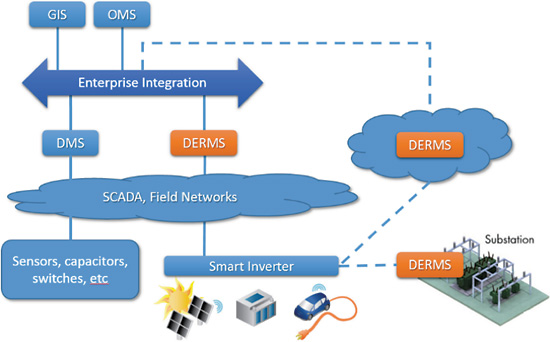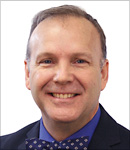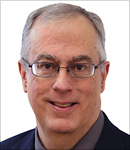Battery storage, solar and wind generation, as well as other distributed energy resources (DER) promise clean energy as well as grid stability benefits. Managing the growing penetration of these resources is becoming a challenge. Coordinated control of these resources depends on communication between back-office systems and devices.
When Distributed Energy Resources (DER) were first being deployed at a scale to become interesting, they typically used inverters to convert direct current (DC) into AC that is synced with the grid. (Wind turbines convert wild' un-synched AC, to steady state DC, then do the AC conversion and syncing with the grid.) Various DER have clean energy benefits or work in combination resources such as wind/solar to mitigate the deleterious effects of unpredictable, variable generation. Additionally, while DER is often touted as a means to provide ancillary services on the grid to stabilize disruptions, the fact is at certain penetrations and locations, DER is the source of the disturbance.
Enter the smart inverter. Beginning in 2008, the Electric Power Resource Institute (EPRI) led an initiative for the industry to define a common set of smart inverter functions. This was a very successful effort with international participation and manufacturers and utilities coming to agreement on what common functions were needed and practical given the state of the technology. Once a menu of standard functions was in place, standard protocols (languages) were developed to communicate settings and status data with the smart inverters. The resulting standard (IEC 61850-90-7) defines these functions and it has been successfully mapped to communication standards such as DNP3, SunSpec Modbus, and Smart Energy Profile 2 (SEP2).
These developments have become the foundation upon which grid codes are being developed worldwide. In the context of DER, grid codes are the laws that dictate what is allowed to be connected to the grid. Grid codes are mandates that require certain grid-supportive characteristics and are put in place in order to enable the grid to support increasing levels of DER. In some cases, grid codes are created at the national level.
The German medium and low voltage grid codes were among the first and most extensive examples of a national grid code. In the US, California is revising the state's Rule 21' which is a code at the state level. Grid codes generally reference the standards, such as the IEC smart inverter standard and communication protocol standards. Such references benefit the manufacturers by providing more consistency in what is needed in the marketplace1.
The next challenge to be addressed is how to manage the communication to all of these devices, especially as the number of deployed resources grows rapidly. The aggregate impact of many small DER, such as residential photovoltaic (PV) systems, is like that of large DER. Makers of distribution management systems (DMS) and utility control room operators typically do not want to view numerous small-scale DER on a device by device basis. They also do not want to view the numerous smart inverter functions and the detailed parameters involved with configuring each function. That level of control is too granular to be useful in the present distribution management environment where there are typically just a few control devices and basic on/off or up/down settings.
The clear distinction between the many field devices with many functional capabilities and the control center need for simplicity creates a need for DER management systems, or DERMS. In view of this, EPRI began work with the US Department of Energy, National Institute of Standards and Technology, Smart Grid Interoperability Panel, and other entities in late 2012 to address this need. EPRI gathered a host of industry stakeholders to coalesce around a common set of use cases that are fitting for DER integration at the enterprise level. This body of work was aimed at addressing the needs for DMS integration of DER, including utility-to-aggregator interfaces and substation or feeder-level management of DER. The core set of use cases is based on the need to manage groups of DER, do maintenance on these groups (creating/deleting groups, adding or removing members), status monitoring of the group, dispatching of the group for real and reactive power, and forecasting of a group's capabilities.
Nominally the DERMS could be thought of as another edge system such as an advanced metering infrastructure (AMI) head-end system that manages the communication with meters, performing meter reading and handling commands and events, while communicating with other back-office systems such as a customer information system (CIS) or meter data management system (MDMS). A DERMS would communicate with individual DER in the field via any of several standardized protocols and would communicate with other interested back-office systems about the status and capabilities of the DER in aggregate. Interested' systems might be, for example, a Distribution Management System (DMS) for group capabilities, an Outage Management System (OMS) for any pertinent events, or a Geospatial Information System (GIS) for locational data or for the nameplate characteristics (rated DER capacity) if a utility is also using the GIS for asset management. The use cases and communication standards for utility application to application or business-to-business integration is typically via Common Information Model (CIM) standard (in this case IEC 61968- 100) or MultiSpeak.™ Other protocols are also possible and could be adapted to support the needs of managing DER in aggregate groups. A DERMS might receive a request from a utility DMS that in essence says, "How many vars can you give me at this location, at this time, for this group?" The DERMS would manage the communication to all of the resources that make up that group, determine the capability, and respond with the vars, duration (how long it could support that request), and the degree of confidence it could meet the request based on its internal algorithms.
During the development of these DERMS use cases EPRI collaborated with the MultiSpeak and IEC standards development organizations (SDOs) so that the messages to support these use cases would be consistent across the two enterprise integration standards. While some of the internal organizing principles are somewhat different, this was a very successful effort to align these standards. During 2013, the DER group monitoring and managing messages were defined using XML Schema Definition (XSD) and published.
However, just having a standard (or a draft of a standard) on paper is not sufficient to prove that it works or to convince industry stakeholders to move forward with products and programs based on the standard. What is needed to close the action' gap is for product manufacturers to implement the new capabilities into their products and test (demonstrate
their capabilities relative to the standard). To facilitate this vendors want specific interpretation and guidance as it relates to the standard. Historically if this guidance is missing, vendors may have different interpretations of the meaning of a standard and implement it in ways that are not interoperable.
To close this gap EPRI worked with industry stakeholders to define a set of tests, with example XML validated against the XSDs (to ensure compliance) which illustrated what a typical request or reply would look like for each of the test cases. Then, late in 2014, EPRI led a testing workshop, cohosted by the Department of Energy and the National Renewable Energy Lab (NREL) and hosted at the Energy Systems Integration Facility (ESIF) in Golden, CO. The workshop was very successful with Spirae, NeBland Software, Boreas Group, Schneider Electric, and Smarter Grid Solutions participating. Additionally, EPRI has continued to develop a Semantic Standard Test Harness to support testing and validation of these and other messages, which is hosted on an Amazon cloud server so that it is available 24x7 for other parties that might be interested in developing DERMS-compliant messages.
Architectural Considerations
While nominally envisioned as an edge server within the utility data center because the message standards are agnostic to architecture (being based on web services) the DERMS could just as well be hosted in the cloud, either managed by a third party aggregator or by the utility. Additionally, for utilities that want to manage the communications and control closer to the resources, the DERMS could just as well be a black box' deployed in the grid, perhaps as a microgrid controller, with the business logic of the control inside the box, while it still speaks the appropriate protocol to devices in the field (e.g. 61850, DNP) and notifies the utility of group actions via CIM or MultiSpeak to the back-office.

Figure 1 - Architecture alternatives that reflect the different ways that a DERMS
could be deployed, at the utility, in the cloud, or in a substation
Standardization Efforts
This work will be officially codified in the next versions of the related CIM and MultiSpeak standards, (5.x for MultiSpeak, IEC 61968-5 for CIM). EPRI is supporting this work in partnership with DOE, NREL, vendors and other industry stakeholders. Plans are already being made to address additional use cases, and make some changes to existing messages based on feedback from vendors that participated in the testing workshop and from the standards development organizations (SDOs). It is anticipated that there will be another testing workshop to vet these changes and new capabilities in the later part of 2015.
Summary
This is definitely an exciting time marked by rapid changes in the capabilities of devices both in terms of load generation and communication capabilities. Via use cases of DERGroup membership, DERGroup status monitoring, and DERGroup forecast and dispatch, new enterprise level capabilities and control are being added just as the amount of DER penetration in the grid is increasing. This promises more reliable and granular control of grid resources even as diversity or energy source and architecture increases.
About the Authors
 Dr. Gerald R. Gray is a Technical Executive at the Electric Power Research Institute (EPRI). He leads the EPRI enterprise architecture and integration program. In this capacity Dr. Gray also participates in the development of numerous industry standards as a member of International Electrotechnical Committee (IEC) TC57, IEC TC8, and MultiSpeak® organizations. He is also participates in the Smart Grid Interoperability Panel as a member of the Smart Grid Architecture Committee (SGAC) and is a member of the GridWise® Architecture Council.
Dr. Gerald R. Gray is a Technical Executive at the Electric Power Research Institute (EPRI). He leads the EPRI enterprise architecture and integration program. In this capacity Dr. Gray also participates in the development of numerous industry standards as a member of International Electrotechnical Committee (IEC) TC57, IEC TC8, and MultiSpeak® organizations. He is also participates in the Smart Grid Interoperability Panel as a member of the Smart Grid Architecture Committee (SGAC) and is a member of the GridWise® Architecture Council.
Dr. Gray has also worked with or contributed to the development of frameworks for topics such as the smart grid, sustainability, and big data. These frameworks include the SEI/CMU Smart Grid Maturity Model (SGMM), the Electric Power Sustainability Model (EPSMM), and the Utility Data Management Framework (UDMF). He earned a Masters of Administrative Sciences in Managing Information Systems from the University of Montana and a Doctor of Philosophy in Organization and Management with a specialization in Information Technology from Capella University.
 Dr. John J. Simmins is a Technical Executive at the Electric Power Research institute (EPRI) where he manages the Information and Communication Technology for Distribution project set. His current research focuses integrating backoffice applications and integrating with devices and personnel in the field. Dr. Simmins also leads the EPRI efforts in the use of augmented reality, social media, data analytics, and visualization to improve grid resilience. Prior to joining EPRI Dr. Simmins was with Southern Maryland Electric Cooperative where he managed the engineering and operations applications. He received his B.S. and a Ph.D. in Ceramic Science from Alfred University.
Dr. John J. Simmins is a Technical Executive at the Electric Power Research institute (EPRI) where he manages the Information and Communication Technology for Distribution project set. His current research focuses integrating backoffice applications and integrating with devices and personnel in the field. Dr. Simmins also leads the EPRI efforts in the use of augmented reality, social media, data analytics, and visualization to improve grid resilience. Prior to joining EPRI Dr. Simmins was with Southern Maryland Electric Cooperative where he managed the engineering and operations applications. He received his B.S. and a Ph.D. in Ceramic Science from Alfred University.
 Brian Seal is a Senior Technical Executive. As such he manages EPRI's Information and Communication Technology research in the areas of advanced metering, demand response, and integration of distributed energy resources. In this role, Brian has been actively involved in international efforts to create standards for interoperability of consumer appliances, solar inverters and smart meters.
Brian Seal is a Senior Technical Executive. As such he manages EPRI's Information and Communication Technology research in the areas of advanced metering, demand response, and integration of distributed energy resources. In this role, Brian has been actively involved in international efforts to create standards for interoperability of consumer appliances, solar inverters and smart meters.
Prior to joining EPRI in 2008, Brian worked for 20 years at Cellnet (now Landis+Gyr) and Schlumberger (now Itron) where he managed product design and development of utility metering and communication equipment. He received Bachelors and Master's degrees in Electrical Engineering from the Georgia Institute of Technology, is an active member of IEEE, IEC and other standards groups, and has been awarded several patents related to utility communication systems.
Reference
1 A point of clarification, it is a bit of a misnomer to refer to this as the California standard.' While the California Public Utility Commission (CPUC) and the utilities in California are doing important work, the standard' is what is defined by the IEC. While it is very quickly being applied in California, it is in fact being used in numerous locations around the globe.
For more information:
- Electric Power Research Institute, et al. Smart Grid Ready PV Inverters with Utility Communication. (February 27, 2014). DOE-FOA-479 Quarterly Report.
- Enterprise Integration Functions for Distributed Energy Resources: Phase 1. EPRI, Palo Alto, CA: 2013. 3002001249.
- Enterprise Integration Functions Test Plan for Distributed Energy Resources, Phase I. EPRI: Palo, Alto, CA. 2014. 3002004681
- Integrating Smart Distributed Energy Resources with Distribution Management Systems. EPRI: Palo, Alto, CA. 2012. 1024360.
- Collaborative Initiative to Advance Enterprise Integration of DER: Workshop Results. EPRI, Palo Alto, CA: 2012. 1026789





